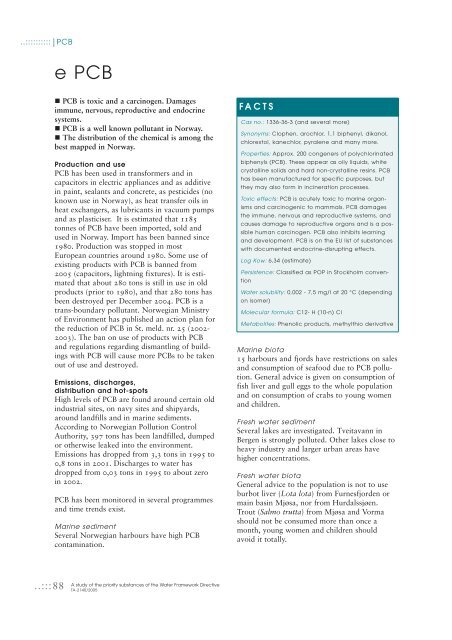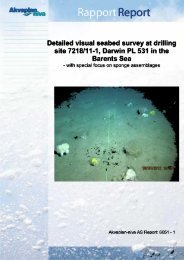A study of the priority substances of the Water Framework Directive ...
A study of the priority substances of the Water Framework Directive ...
A study of the priority substances of the Water Framework Directive ...
Create successful ePaper yourself
Turn your PDF publications into a flip-book with our unique Google optimized e-Paper software.
..:::::::::: PCB<br />
..:::88<br />
e PCB<br />
� PCB is toxic and a carcinogen. Damages<br />
immune, nervous, reproductive and endocrine<br />
systems.<br />
� PCB is a well known pollutant in Norway.<br />
� The distribution <strong>of</strong> <strong>the</strong> chemical is among <strong>the</strong><br />
best mapped in Norway.<br />
Production and use<br />
PCB has been used in transformers and in<br />
capacitors in electric appliances and as additive<br />
in paint, sealants and concrete, as pesticides (no<br />
known use in Norway), as heat transfer oils in<br />
heat exchangers, as lubricants in vacuum pumps<br />
and as plasticiser. It is estimated that 1185<br />
tonnes <strong>of</strong> PCB have been imported, sold and<br />
used in Norway. Import has been banned since<br />
1980. Production was stopped in most<br />
European countries around 1980. Some use <strong>of</strong><br />
existing products with PCB is banned from<br />
2005 (capacitors, lightning fixtures). It is estimated<br />
that about 280 tons is still in use in old<br />
products (prior to 1980), and that 280 tons has<br />
been destroyed per December 2004. PCB is a<br />
trans-boundary pollutant. Norwegian Ministry<br />
<strong>of</strong> Environment has published an action plan for<br />
<strong>the</strong> reduction <strong>of</strong> PCB in St. meld. nr. 25 (2002-<br />
2003). The ban on use <strong>of</strong> products with PCB<br />
and regulations regarding dismantling <strong>of</strong> buildings<br />
with PCB will cause more PCBs to be taken<br />
out <strong>of</strong> use and destroyed.<br />
Emissions, discharges,<br />
distribution and hot-spots<br />
High levels <strong>of</strong> PCB are found around certain old<br />
industrial sites, on navy sites and shipyards,<br />
around landfills and in marine sediments.<br />
According to Norwegian Pollution Control<br />
Authority, 397 tons has been landfilled, dumped<br />
or o<strong>the</strong>rwise leaked into <strong>the</strong> environment.<br />
Emissions has dropped from 3,3 tons in 1995 to<br />
0,8 tons in 2001. Discharges to water has<br />
dropped from 0,03 tons in 1995 to about zero<br />
in 2002.<br />
PCB has been monitored in several programmes<br />
and time trends exist.<br />
Marine sediment<br />
Several Norwegian harbours have high PCB<br />
contamination.<br />
A <strong>study</strong> <strong>of</strong> <strong>the</strong> <strong>priority</strong> <strong>substances</strong> <strong>of</strong> <strong>the</strong> <strong>Water</strong> <strong>Framework</strong> <strong>Directive</strong><br />
TA-2140/2005<br />
FACTS<br />
Cas no.: 1336-36-3 (and several more)<br />
Synonyms: Clophen, arochlor, 1,1 biphenyl, dikanol,<br />
chlorextol, kanechlor, pyralene and many more.<br />
Properties: Approx. 200 congeners <strong>of</strong> polychlorinated<br />
biphenyls (PCB). These appear as oily liquids, white<br />
crystalline solids and hard non-crystalline resins. PCB<br />
has been manufactured for specific purposes, but<br />
<strong>the</strong>y may also form in incineration processes.<br />
Toxic effects: PCB is acutely toxic to marine organisms<br />
and carcinogenic to mammals. PCB damages<br />
<strong>the</strong> immune, nervous and reproductive systems, and<br />
causes damage to reproductive organs and is a possible<br />
human carcinogen. PCB also inhibits learning<br />
and development. PCB is on <strong>the</strong> EU list <strong>of</strong> <strong>substances</strong><br />
with documented endocrine-disrupting effects.<br />
Log Kow: 6,34 (estimate)<br />
Persistence: Classified as POP in Stockholm convention<br />
<strong>Water</strong> solubility: 0,002 - 7,5 mg/l at 20 °C (depending<br />
on isomer)<br />
Molecular formula: C12- H (10-n) Cl<br />
Metabolites: Phenolic products, methylthio derivative<br />
Marine biota<br />
15 harbours and fjords have restrictions on sales<br />
and consumption <strong>of</strong> seafood due to PCB pollution.<br />
General advice is given on consumption <strong>of</strong><br />
fish liver and gull eggs to <strong>the</strong> whole population<br />
and on consumption <strong>of</strong> crabs to young women<br />
and children.<br />
Fresh water sediment<br />
Several lakes are investigated. Tveitavann in<br />
Bergen is strongly polluted. O<strong>the</strong>r lakes close to<br />
heavy industry and larger urban areas have<br />
higher concentrations.<br />
Fresh water biota<br />
General advice to <strong>the</strong> population is not to use<br />
burbot liver (Lota lota) from Furnesfjorden or<br />
main basin Mjøsa, nor from Hurdalssjøen.<br />
Trout (Salmo trutta) from Mjøsa and Vorma<br />
should not be consumed more than once a<br />
month, young women and children should<br />
avoid it totally.

















